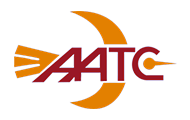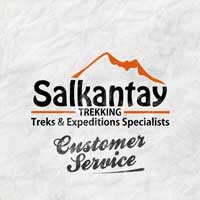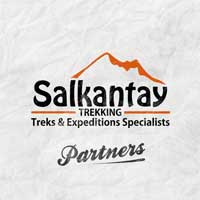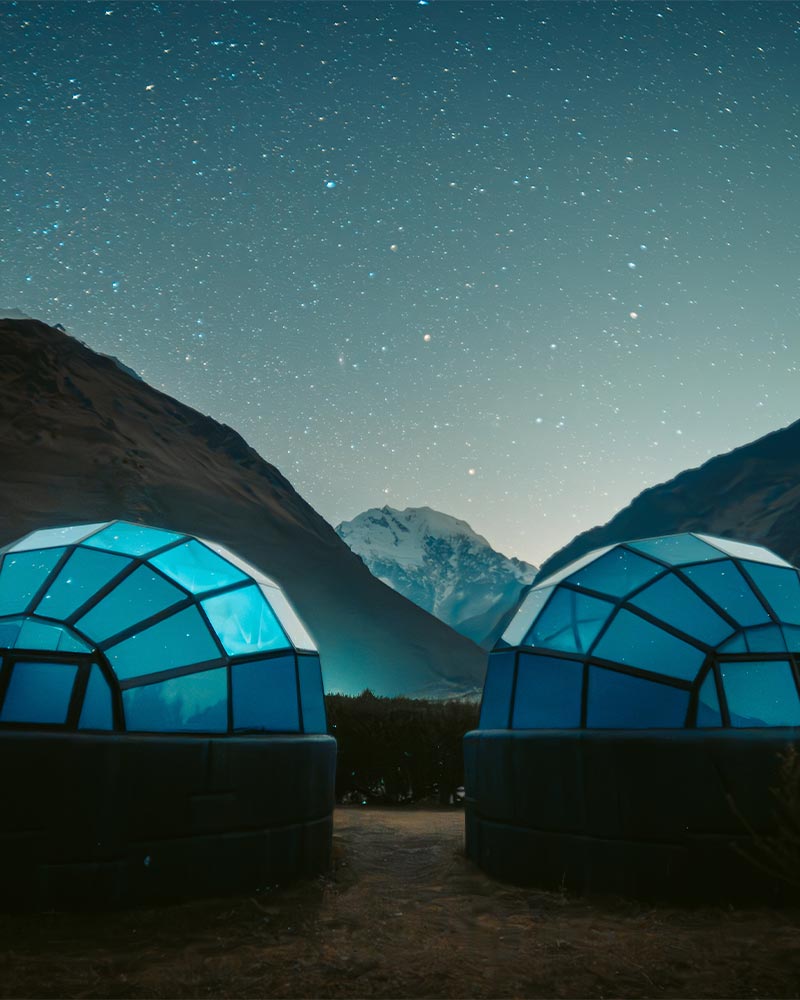The ultimate Salkantay Trek to Machu Picchu Packing List
You've decided to join us on the unforgettable Salkantay Trek to Machu Picchu in the stunning Peruvian Andes!
We're confident you're excited and can't wait to begin your journey. But first, you need to know everything you'll need along the way.
The Salkantay Trek is considered one of the best alternatives to the famous Inca Trail, offering an unforgettable experience for nature lovers and those interested in Peruvian culture. That's why we've created the ultimate Salkantay Trek packing list, which will help you prepare for this thrilling outdoor adventure in one of the most impressive regions of South America.
These recommendations are based on our equipment and experience, and we believe they offer the best value for optimal performance. Here's a summary of the essential items you'll need, tailored to the seasons and destination of your journey.
Look at our Salkantay Trek to Machu Picchu packing list and prepare for an unforgettable adventure!
You've decided to join us on the unforgettable Salkantay Trek to Machu Picchu in the stunning Peruvian Andes!
These recommendations are based on our equipment and experience, and we believe they offer the best value for optimal performance. Here's a summary of the essential items you'll need, tailored to the seasons and destination of your journey.
The Ultimate Salkantay Trek Packing List
Documents
Original Passport (for entrance to Machu Picchu)
Of course, you will need your passport to enter our country, but it is also a requirement for embarking on your hike. There is an official government checkpoint at the beginning of the trail that enforces strict daily visitor limits. Remember that all foreign visitors must present their passports before starting the excursion.
Furthermore, if your hike concludes at Machu Picchu, you won't be able to enter the citadel without your passport. Double-check that your passport details match your entry ticket information to avoid inconveniences.
Backpack and Duffle Bag
Backpack
Along our routes, a porter or mule usually carries your duffle bag or large rucksack. This means you need a lightweight daypack to carry essentials—snacks, water, a camera, sunscreen, etc.
We suggest a backpack with compression straps to reduce weight stress on your back, and side mesh pockets for quick access to your water bottle. The Osprey Talon is our recommended backpack.
It’s important you bring a rain cover for your rucksack as you never know when there’ll be a downpour in the Andes. If you decide to use an Osprey backpack, then make sure you get an Osprey Raincover that matches the bag size for a snug fit.
Duffle Bag (included in the service)
Before starting your trek, you will receive a small canvas bag to store your clothes and other essential items. You can carry up to 7 kg of weight.
Our horseman will carry your duffle bag for you, together with the food and camping gear, along the entire route. It’s important to note that you won’t have access to your items in the duffle bag until the end of each day at the campsites—the horsemen and horses will always be ahead of the group.
During the day, you'll need a spacious backpack to carry your belongings: warm clothing, a windbreaker, a camera, sunscreen, snacks, water, etc. A 30-liter backpack is usually sufficient.
Clothing for Salkantay Trek
Underwear
Choosing the right underwear is crucial for your comfort during hiking. We recommend bringing 4 to 6 pairs of high-quality underwear.
In particular, we recommend renowned brands like Icebreaker, Adidas, or Under Armour, which specialize in manufacturing sportswear underwear. These brands offer products specifically designed for high-intensity activities and help control perspiration during exercise.
Base Layer
The base layer, or the next-to-skin or first layer, is essential on the higher parts of the Salkantay Trek, where it can get very cold and sometimes below 0°C.
The best first layers fit snugly to the body (reducing air pockets and flow) and consist of high-wicking materials to facilitate moisture transfer.
We recommend getting 2 top and one bottom base layers for the first two days.
Trekking Shirts
You’ll need to bring 4–7 trekking shirts—depending on whether you’re doing a short or long trek). We recommend these breathable and lightweight shirts from Hanes. Alternatively, shirts from Icebreaker or Columbia are also of great quality.
Don’t bring cotton shirts as these absorb moisture and can make you feel very uncomfortable. A mixture of short and long sleeve shirts is recommended for the differing climates.
Hard Shell Jacket and Rain Gear
Rain is always possible when trekking in Peru, particularly during the rainy season (October-March). You should bring a hard-shell jacket for ultimate protection when it’s wet, like the North Face Resolve Jacket.
It’s also worth taking a compact rain poncho that can quickly be put on should you encounter a light downpour—especially useful for the jungle.
Insulated Jacket
The outer layer is essential for the Salkantay Trek. We recommend a waterproof jacket and pants. The Nuptse Jacket by The North Face is a market leader and offers excellent warmth and weight characteristics. It's a durable investment that will serve you for years of hiking and also functions as a winter jacket in the city.
Other renowned brands include Patagonia Down Jacket, Arc'Teryx Atom, and Mountain Hardwear Down Jackets.
Fleece Jacket
The second layer, or what we call the insulation layer, should be made from fleece material.
We recommend a Polartec 200 Fleece Jacket. These insulation jackets are perfect for hiking as they provide a great warmth-to-weight ratio whilst allowing effective moisture transfer. The Polartec 100s are lighter but not warm enough for the Salkantay Trek, whereas the Polartec 300s are too heavy, in our opinion.
Recommended fleece brands included Helly Hansen, The North Face, and Patagonia.
Trekking Pants and Shorts
For your Salkantay trek, it's important to include specific hiking pants and shorts in your packing list. There are various brands available, but we recommend considering Craghoppers, Columbia, or O'Neills.
A convenient option is convertible pants, like the model designed by Craghoppers. These pants allow you to save money as you won't need to buy separate shorts, while providing comfort during your hike.
Not only will they save you money by eliminating the need for separate shorts, but they also offer comfort. We suggest bringing two pairs of pants and one pair of shorts to have suitable options for different weather conditions and personal preferences.
Pajama Pants
Whether you wear sweatpants or pajama pants, these are recommended for you to unwind in the campsites and get cozy in your bed. It gets chilly at night, so make sure you opt for warm, long pants.
Inner Gloves
An inner glove acts as your next-to-skin layer, like the base layer of clothing we described above. You should bring a lightweight, quick-drying inner glove, ideally made from fleece material.
We recommend Pearl Izumi Thermal Lite Gloves, which can also be used as standalone gloves when the weather is moderately cold. Karrimor is another quality brand.
Headgear for Salkantay Trek
Hat for Sun Protection
You must bring a hiking hat that protects face and neck from the glaring sun. It’s easy to get burnt at high altitudes in just a few minutes.
Your hat should be light and easy to bend/fold so that it can fit into your backpack or rucksack. Trekking hats with a neck cover are great to give you ultimate protection.
Head Band or Beanie
Temperatures can get very cold in the evenings and early mornings, particularly as you reach the higher altitudes on the Salkantay Trek or head out on the Ausangate trails.
A warm fleeced beanie or fleeced headband are absolute must-haves. Berghaus and The North Face provide some fantastic beanies that are ideal for trekking in the cold.
Neck Gaiter or Balaclava
A neckband or balaclava that can keep your neck and face warm when temperatures drop below freezing is also a must-have.
We highly recommend taking one fleeced buff and one thin buff.
Buffs are super versatile and can be used as headbands, beanies, neck gaiters, and wristbands, as demonstrated in the image.
Footwear for Salkantay Trek
Hiking Boots
Mountain boots are crucial for the Salkantay trek. To avoid injuries and blisters, it's important to find the right fit. When trying them on, make sure your toes touch the front of the boot and you can insert an index finger at the back.
Some reliable brands of mountain boots include Scarpa, Salomon (we recommend the Quest range), Berghaus (we recommend the Explorer range), Hi-Tec, and Karrimor.
Sneakers (Trekking Shoes/Sandals)
After a long day of hiking across rough terrain, the first thing you will want to do is change into a comfortable pair of shoes. We recommend bringing trekking shoes, sneakers, or sandals. We like Merrel trekking shoes, and trekking sandals are great to wear with warm socks for optimum comfort.
Hiking Socks
You’ll need 5–6 hiking socks and 4–5 high-wicking sock liners.
We recommend Coolmax hiking socks as they provide excellent breathability and have fantastic wicking properties. Smartwool, Bridgedale, and Point 6 also make great socks.
Don’t bring cotton socks, as these will lead to nasty blisters and sweating.
Camping Equipment
Sleeping Bag
Prepare a warm sleeping bag for our excursions as the nights can be very cold, even below 0°C. Down bags made of duck or goose feathers are the best but also more expensive. If you're looking for a more budget-friendly option, choose a synthetic bag with a minimum temperature rating of -10°C. Opt for a mummy-shaped bag with a hood and adjustable drawstring. Some recommended brands include The North Face Snow Leopard, Marmot Trestles, Mountain Hardwear Phantom Highlander, and Coleman.
*If you don't have a sleeping bag, at Salkantay Trekking, we offer the rental service of this and other camping equipment, so you can use them during your Salkantay trek.
Important Accessories for Salkantay Trek
Trekking Poles
High-quality walking poles can reduce the impact on your knees and leg joints by up to 20 percent. Trekking poles are particularly useful when descending, as the load on your joints increases exponentially when going downhill.
We recommend getting lightweight (around 350 grams per pair) and adjustable trekking poles, as they are easy to store and very versatile. Black Diamond walking poles are excellent, as are Leki poles.
*If you don't have trekking poles, at Salkantay Trekking, we can rent you these and other camping equipment so you can use them during the Salkantay trail.
Sunglasses
The UV intensity in Cusco, Peru, is very high due to the high altitude and glare from the snowy mountain peaks.
You should bring a quality pair of UV protection sunglasses (minimum of 80% light reduction). We recommend mountain sunglasses from Julbo.
Flashlight or Headlamp
You won’t be hiking at night, but you might need to go to the toilet in the dark or want to read before bed. Many of the teahouses and campsites are poorly lit or have no electricity at all, so extra lighting is very helpful.
Petzl Tikka is the best headlamp brand. Don’t forget to bring spare batteries as well.
Water Bottle or Hydration Bladder
Many people suffer from dehydration at high altitudes. You should aim to drink 2–3 liters of water a day. Heatstroke and dizziness are common for dehydrated trekkers and could cause you to miss out on the rest of your hike.
Water can be carried in a standard water bottle—we recommend getting 2 x 1L CamelBak Water Bottles.
Or, if your daypack includes space for a hydration bladder, then the 2L Platypus Hydration Bladder is an excellent product.
Camera
The scenery in Cusco, Peru, is amazing! You’ll definitely want to capture your experience in HD, so if you don’t have a decent camera, now’s the time to get one.
Here are some recommended and affordable Digital SLR cameras. Remember, you want to make sure your camera is light but still able to capture high-quality images. We like the Panasonic Lumex. If you’re more inclined to take videos, then you might want to consider GoPro.
Notebook/Journal & Pen
This isn’t a must but is a great way to chronicle your trek, so you remember every last detail.
Personal Gear and Medication for Salkantay Trek
-
Swimsuit
If you plan on taking a dip in Aguas Calientes hot springs, this is a must. On some routes, there are also opportunities to swim.
-
Trekking Towel
A small to medium-sized hiking towel can come in very handy. LifeVentures or Discovery provide good, quick-drying trekking towels.
-
Cash
Along the route, there are spots to buy snacks and water. It’s also a great idea to have extra cash (S/300–S/400) in case of an emergency.
-
Toilet Paper
You might need to go to the bathroom during the day. You’ll need toilet paper as most toilets don’t usually provide this.
-
Portable Power Pack
Although there are opportunities to charge devices on some treks, portable power is a great idea so you can charge anytime, anywhere.
-
Small Locks
To protect your belongings in your rucksack or duffle bag.
-
Waterproof Ziplock Bags
These come in handy for storing important/valuable items like your money, passport, and electrical equipment
-
Isotonic Powder
Can be used to flavor your water and helps replace electrolytes, improving energy levels and aiding water absorption.
-
Diamox
Acetazolamide, or altitude sickness medication, can be used as a preventive measure. It is important to note that it does not cure altitude sickness and should not be relied upon as a solution for extreme altitudes. However, it can help mitigate its effects, which is why it is popular among climbers and hikers.
-
General Medications
We recommend taking paracetamol or aspirin for headaches (a common altitude sickness symptom on the Salkantay Trek) and Immodium for diarrhea.
-
Basic First Aid Kit
If you’re joining an organized trek, your guide will most likely be carrying a first aid kit. If you’re hiking unsupported or independently, then a first aid kit is a must.
-
Sunscreen/Lip balm
No one wants burnt skin or cracked lips. Be sure to bring 1 x sunscreen (SPF 50+), and 1 x lip balm.
-
Bug Spray/Repellent
As you get closer and closer to Machu Picchu, you’ll come across more bugs that like to bite! You’ll need this to keep them away.
-
Baby Wipes/Body Wipes
For quick and easy wet washes when no showers are in sight! Bring 1 x baby wipes or body wipes.
-
Blister Plasters
The dreaded blisters! We recommend taking Compeed blister plasters
-
Hand Sanitizer
Great for disinfecting hands before and after eating or when they get dirty during the hike.
What to Pack in Your Backpack?
We’ve already mentioned the importance of having a lightweight, quality backpack to carry the necessities in during the day. However, you might still wonder what needs to go in there and what to put in your duffle bag. Fear not! We’ve compiled a checklist of everything that needs to go in your daypack.
- Rain jacket/poncho
- Fleece
- Sunhat/beanie
- Water bottle
- Bug spray
- Sunscreen
- Personal medication
- Toilet paper
- Cash
- Passport
- Camera
Find the Perfect Destination in Peru
With astonishingly varied landscapes, stunning scenery, compelling history, and a legacy of fascinating cultures, there is truly something for everyone. Our expeditions in Peru are designed to showcase all that this country has to offer.
Our expeditions in Peru are designed to showcase all that this country has to offer.











